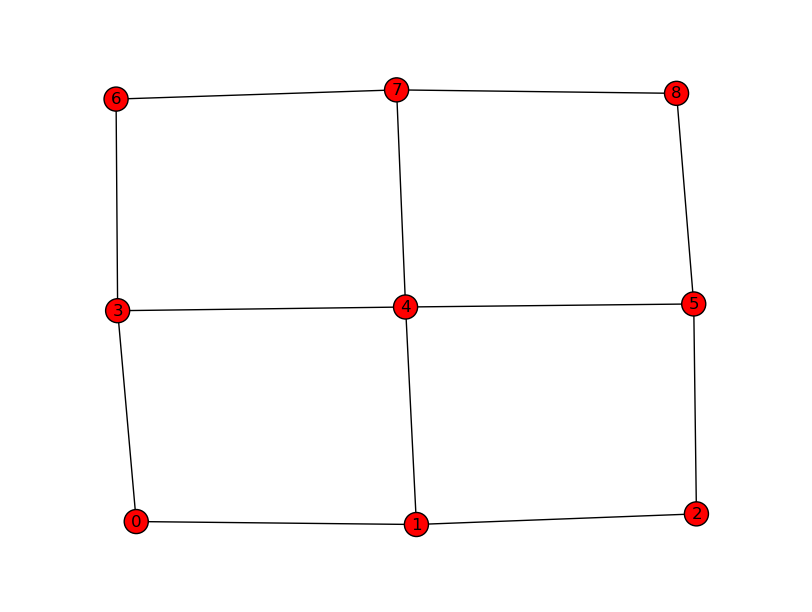我一直在寻找一个 python 实现,它返回一个 4 或 8 连接的邻接矩阵,给定一个数组。我发现 cv2 或 networkx 不包含此功能令人惊讶。我遇到了这个很棒的 Matlab implementation并决定用 Python 做一些类似的东西。
问题:我正在寻找一种在运行时/空间或其他有趣方法中改进链接的 Matlab 解决方案的实现。
免责声明:
我在这里提交我自己的实现,因为我认为我不可能是唯一需要为图像处理或其他应用程序创建(4/8 连接)邻接矩阵的人。我希望能提供改进或更好的实现。
最佳答案
使用对角线结构,详见this answer关于“在 MATLAB 中构建邻接矩阵”,我只创建上对角线并使用 scipy.sparse.diags 将它们添加到稀疏对角矩阵的适当位置。 .这个稀疏矩阵被添加到它的转置中,得到邻接矩阵。
在处理图像时,通常需要将图像分解为不重叠的矩形子图像或 block 。 patch_size 参数是一个元组 (rows, cols),它描述了大小为 'rows x cols' 的矩形补丁。
import numpy as np
import scipy.sparse as s
def connected_adjacency(image, connect, patch_size=(1, 1)):
"""
Creates an adjacency matrix from an image where nodes are considered adjacent
based on 4-connected or 8-connected pixel neighborhoods.
:param image: 2 or 3 dim array
:param connect: string, either '4' or '8'
:param patch_size: tuple (n,m) used if the image will be decomposed into
contiguous, non-overlapping patches of size n x m. The
adjacency matrix will be formed from the smaller sized array
e.g. original image size = 256 x 256, patch_size=(8, 8),
then the image under consideration is of size 32 x 32 and
the adjacency matrix will be of size
32**2 x 32**2 = 1024 x 1024
:return: adjacency matrix as a sparse matrix (type=scipy.sparse.csr.csr_matrix)
"""
r, c = image.shape[:2]
r = r / patch_size[0]
c = c / patch_size[1]
if connect == '4':
# constructed from 2 diagonals above the main diagonal
d1 = np.tile(np.append(np.ones(c-1), [0]), r)[:-1]
d2 = np.ones(c*(r-1))
upper_diags = s.diags([d1, d2], [1, c])
return upper_diags + upper_diags.T
elif connect == '8':
# constructed from 4 diagonals above the main diagonal
d1 = np.tile(np.append(np.ones(c-1), [0]), r)[:-1]
d2 = np.append([0], d1[:c*(r-1)])
d3 = np.ones(c*(r-1))
d4 = d2[1:-1]
upper_diags = s.diags([d1, d2, d3, d4], [1, c-1, c, c+1])
return upper_diags + upper_diags.T
else:
raise ValueError('Invalid parameter \'connect\'={connect}, must be "4" or "8".'
.format(connect=repr(connect)))
一个简单的例子:
a = np.arange(9).reshape((3, 3))
adj = connected_adjacency(a, '4').toarray()
print a
[[0 1 2]
[3 4 5]
[6 7 8]]
print adj
[[ 0. 1. 0. 1. 0. 0. 0. 0. 0.]
[ 1. 0. 1. 0. 1. 0. 0. 0. 0.]
[ 0. 1. 0. 0. 0. 1. 0. 0. 0.]
[ 1. 0. 0. 0. 1. 0. 1. 0. 0.]
[ 0. 1. 0. 1. 0. 1. 0. 1. 0.]
[ 0. 0. 1. 0. 1. 0. 0. 0. 1.]
[ 0. 0. 0. 1. 0. 0. 0. 1. 0.]
[ 0. 0. 0. 0. 1. 0. 1. 0. 1.]
[ 0. 0. 0. 0. 0. 1. 0. 1. 0.]]
使用 networkx + matplotlib 将邻接矩阵绘制为图形:

关于python - 如何创建 4 或 8 连接的邻接矩阵,我们在Stack Overflow上找到一个类似的问题: https://stackoverflow.com/questions/30199070/